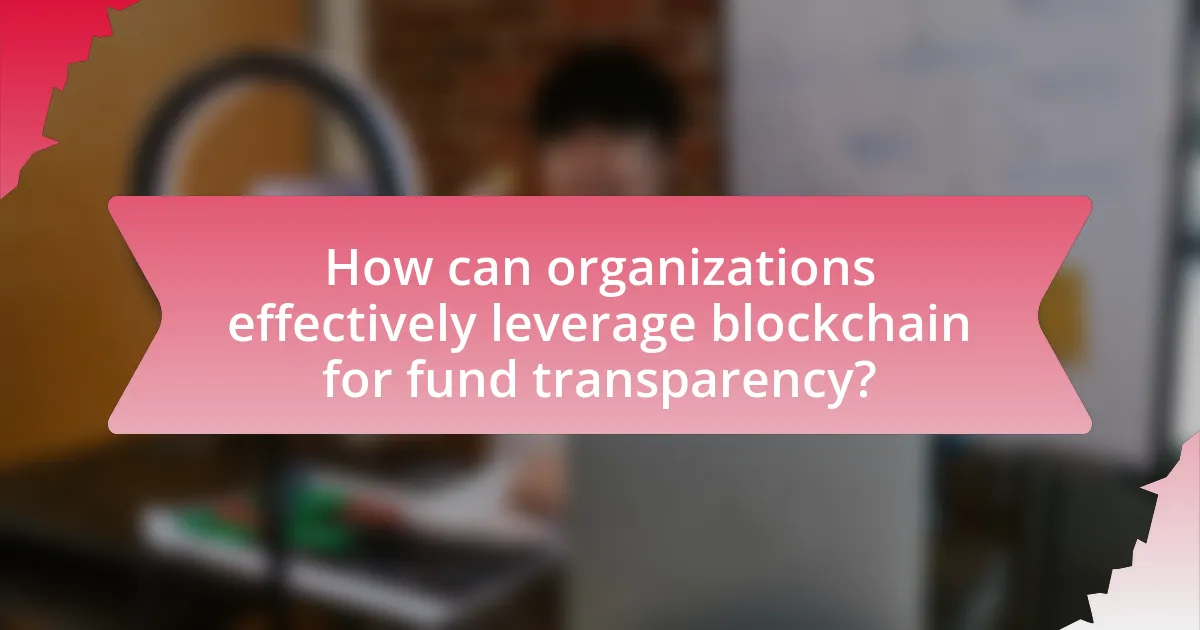Leveraging blockchain technology for fund transparency involves the use of decentralized ledger systems to improve the visibility and traceability of financial transactions. This technology enhances accountability by allowing stakeholders to access real-time data on fund allocation and usage, thereby reducing the risk of fraud. Key features such as immutability, decentralization, and public accessibility support this transparency, fostering trust among investors and stakeholders. The article also addresses the importance of fund transparency in today’s financial landscape, the risks associated with its absence, and the challenges organizations face in implementing blockchain solutions. Additionally, it explores the role of smart contracts in automating processes and ensuring compliance, while highlighting future trends and practical steps for organizations to enhance fund transparency through blockchain technology.

What is Leveraging Blockchain Technology for Fund Transparency?
Leveraging blockchain technology for fund transparency involves utilizing decentralized ledger systems to enhance the visibility and traceability of financial transactions. This technology allows stakeholders to access real-time data regarding fund allocation and usage, ensuring accountability and reducing the risk of fraud. For instance, organizations like the World Wildlife Fund have implemented blockchain to track donations, providing donors with transparent insights into how their contributions are utilized. This approach not only fosters trust among contributors but also aligns with regulatory compliance by maintaining an immutable record of transactions.
How does blockchain technology enhance fund transparency?
Blockchain technology enhances fund transparency by providing a decentralized and immutable ledger that records all transactions in real-time. This transparency allows stakeholders to verify and audit transactions independently, reducing the risk of fraud and mismanagement. For instance, in 2021, the World Economic Forum highlighted that blockchain can increase trust among participants by ensuring that all transaction data is publicly accessible and cannot be altered retroactively. This level of transparency fosters accountability and encourages responsible financial practices.
What are the key features of blockchain that support transparency?
The key features of blockchain that support transparency include immutability, decentralization, and public accessibility. Immutability ensures that once data is recorded on the blockchain, it cannot be altered or deleted, which preserves the integrity of transactions. Decentralization distributes control across a network of nodes, reducing the risk of manipulation by a single entity. Public accessibility allows anyone to view the transaction history on the blockchain, fostering trust among users. These features collectively enhance accountability and traceability in financial transactions, as evidenced by the use of blockchain in supply chain management, where stakeholders can verify the origin and movement of goods in real-time.
How does decentralization contribute to fund transparency?
Decentralization enhances fund transparency by distributing control and oversight across multiple participants rather than a single entity. This structure allows for real-time tracking of transactions on a public ledger, ensuring that all stakeholders can independently verify fund flows. For instance, blockchain technology, which operates on decentralized networks, records every transaction in an immutable manner, making it nearly impossible to alter or hide financial activities. Research by the World Economic Forum indicates that decentralized systems can reduce fraud and increase accountability, as all transactions are visible to authorized users, thereby fostering trust among participants.
Why is fund transparency important in today’s financial landscape?
Fund transparency is crucial in today’s financial landscape because it fosters trust and accountability among investors and stakeholders. In an era marked by financial scandals and mismanagement, transparent funds allow investors to understand where their money is going, how it is being managed, and the associated risks. For instance, a 2021 study by the CFA Institute found that 78% of investors consider transparency a key factor in their investment decisions. This level of transparency not only enhances investor confidence but also encourages better regulatory compliance and reduces the likelihood of fraud.
What are the risks associated with lack of transparency in fund management?
The risks associated with lack of transparency in fund management include increased potential for fraud, misallocation of resources, and diminished investor confidence. When fund managers do not provide clear information about their operations, it becomes easier for dishonest practices to occur, as stakeholders cannot effectively monitor activities. A study by the CFA Institute highlights that opaque fund management can lead to significant financial losses for investors, as they may unknowingly invest in poorly managed or fraudulent funds. Furthermore, a lack of transparency can result in regulatory scrutiny and legal repercussions, as seen in cases like the Enron scandal, where hidden financial practices led to the company’s collapse and loss of billions in investor capital.
How does transparency impact stakeholder trust and engagement?
Transparency significantly enhances stakeholder trust and engagement by fostering open communication and accountability. When organizations provide clear and accessible information about their operations, stakeholders feel more informed and valued, which strengthens their trust. For instance, a study by the Harvard Business Review found that companies with high transparency levels experience a 20% increase in stakeholder engagement, as stakeholders are more likely to participate in initiatives when they understand the processes and decisions involved. This increased trust leads to stronger relationships, higher loyalty, and greater collaboration among stakeholders, ultimately benefiting the organization’s overall performance.
What challenges exist in implementing blockchain for fund transparency?
Implementing blockchain for fund transparency faces several challenges, including scalability, regulatory compliance, and integration with existing systems. Scalability issues arise as blockchain networks can struggle to handle a high volume of transactions efficiently, which is critical for real-time fund tracking. Regulatory compliance is another significant challenge, as varying laws across jurisdictions can complicate the adoption of blockchain solutions. Additionally, integrating blockchain with legacy financial systems can be complex and costly, hindering widespread implementation. These challenges highlight the need for careful planning and collaboration among stakeholders to effectively leverage blockchain technology for enhanced fund transparency.
What are the technical barriers to adopting blockchain technology?
The technical barriers to adopting blockchain technology include scalability issues, interoperability challenges, and high energy consumption. Scalability refers to the difficulty in processing a large number of transactions quickly; for instance, Bitcoin can handle approximately 7 transactions per second, while traditional payment systems like Visa can process over 24,000 transactions per second. Interoperability challenges arise from the existence of multiple blockchain platforms that do not communicate with each other, hindering seamless integration. Additionally, high energy consumption is a significant concern, as the proof-of-work consensus mechanism used by many blockchains requires substantial computational power, leading to environmental impacts and increased operational costs. These barriers collectively impede widespread adoption of blockchain technology in various sectors.
How do regulatory concerns affect the use of blockchain in fund management?
Regulatory concerns significantly impact the use of blockchain in fund management by imposing compliance requirements that can hinder innovation and adoption. Fund managers must navigate complex regulations related to anti-money laundering (AML), know your customer (KYC) protocols, and securities laws, which can limit the flexibility and transparency that blockchain technology offers. For instance, the European Union’s Markets in Crypto-Assets (MiCA) regulation aims to create a comprehensive regulatory framework for digital assets, which could affect how blockchain is integrated into fund management practices. Compliance with such regulations often requires additional resources and can slow down the implementation of blockchain solutions, ultimately affecting the efficiency and cost-effectiveness that blockchain could provide in fund management.

How can organizations effectively leverage blockchain for fund transparency?
Organizations can effectively leverage blockchain for fund transparency by utilizing its immutable ledger to record all transactions in real-time. This technology ensures that every financial transaction is securely documented and publicly accessible, which significantly reduces the risk of fraud and mismanagement. For instance, a study by the World Economic Forum indicates that blockchain can enhance transparency in supply chains, allowing stakeholders to track the flow of funds and verify their usage. By implementing smart contracts, organizations can automate fund disbursement based on predefined conditions, further ensuring accountability and traceability.
What steps should organizations take to implement blockchain solutions?
Organizations should take the following steps to implement blockchain solutions: first, they must identify specific use cases that align with their goals, such as enhancing fund transparency. Next, organizations should conduct a thorough assessment of their current infrastructure to determine compatibility with blockchain technology. Following this, they need to select the appropriate blockchain platform based on scalability, security, and functionality requirements.
Subsequently, organizations should engage stakeholders to gather input and ensure alignment on objectives. Afterward, they should develop a prototype or pilot project to test the blockchain solution in a controlled environment. This allows for the identification of potential challenges and the refinement of the approach.
Finally, organizations must establish a comprehensive implementation plan that includes training for staff, integration with existing systems, and ongoing monitoring and evaluation to ensure the solution meets its intended goals. These steps are supported by the fact that successful blockchain implementations often follow a structured approach, as seen in various case studies across industries.
How can organizations assess their readiness for blockchain adoption?
Organizations can assess their readiness for blockchain adoption by evaluating their current technological infrastructure, understanding the specific use cases for blockchain within their operations, and analyzing their workforce’s skill set. A comprehensive readiness assessment involves conducting a gap analysis to identify existing capabilities versus the requirements for successful blockchain implementation. According to a report by Deloitte, 39% of organizations that have adopted blockchain cite a lack of skilled personnel as a significant barrier, highlighting the importance of workforce readiness. Additionally, organizations should consider regulatory compliance and the alignment of blockchain technology with their strategic goals to ensure a smooth transition.
What are the best practices for integrating blockchain into existing systems?
The best practices for integrating blockchain into existing systems include conducting a thorough needs assessment, ensuring interoperability with current technologies, and prioritizing security and compliance. A needs assessment identifies specific use cases where blockchain adds value, such as enhancing transparency in fund management. Interoperability ensures that blockchain solutions can communicate with existing systems, which is crucial for seamless data exchange. Security measures, including encryption and access controls, protect sensitive information, while compliance with regulations ensures that the integration meets legal standards. These practices are supported by industry reports indicating that successful blockchain implementations often hinge on these foundational steps, leading to improved operational efficiency and trust in fund transparency initiatives.
What role do smart contracts play in enhancing fund transparency?
Smart contracts enhance fund transparency by automating and enforcing the terms of agreements on a blockchain, ensuring that all transactions are recorded in a tamper-proof manner. This automation reduces the risk of human error and fraud, as the execution of contract terms occurs without the need for intermediaries. For instance, in a study by the World Economic Forum, it was noted that smart contracts can provide real-time tracking of fund allocation and usage, allowing stakeholders to verify transactions independently. This level of transparency fosters trust among participants, as all actions are visible and immutable on the blockchain.
How do smart contracts automate processes related to fund management?
Smart contracts automate processes related to fund management by executing predefined agreements automatically when specific conditions are met. This automation reduces the need for intermediaries, minimizes human error, and enhances efficiency in transactions. For instance, smart contracts can facilitate automatic fund disbursement based on milestones or performance metrics, ensuring that funds are released only when agreed-upon criteria are satisfied. Additionally, they provide transparency and traceability, as all transactions are recorded on a blockchain, allowing stakeholders to verify fund allocation and usage in real-time. This capability is supported by the inherent features of blockchain technology, which ensures data integrity and security, thereby reinforcing trust among participants in fund management.
What are the benefits of using smart contracts for compliance and auditing?
Smart contracts enhance compliance and auditing by automating processes, ensuring accuracy, and providing transparency. They execute predefined rules and conditions without human intervention, which reduces the risk of errors and fraud. For instance, smart contracts can automatically verify compliance with regulations by checking transactions against established criteria in real-time. This capability not only streamlines auditing processes but also ensures that all transactions are recorded on an immutable blockchain, providing a reliable audit trail. According to a report by Deloitte, the use of smart contracts can significantly reduce compliance costs and improve operational efficiency by up to 30%.

What are the future trends in leveraging blockchain for fund transparency?
Future trends in leveraging blockchain for fund transparency include the increased adoption of decentralized finance (DeFi) platforms, which utilize smart contracts to automate and verify transactions transparently. This trend is supported by the growing demand for real-time auditing capabilities, as blockchain allows for continuous monitoring of fund flows, reducing the risk of fraud. Additionally, regulatory bodies are beginning to embrace blockchain technology for compliance purposes, enhancing transparency in financial reporting. According to a report by Deloitte, 40% of financial services firms are exploring blockchain solutions to improve transparency and efficiency in their operations.
How is the adoption of blockchain technology expected to evolve?
The adoption of blockchain technology is expected to evolve significantly as industries increasingly recognize its potential for enhancing transparency and security. According to a report by Gartner, by 2025, 75% of organizations will be using blockchain technology in some form, driven by the demand for improved data integrity and traceability in transactions. This trend is particularly evident in sectors such as finance, supply chain, and healthcare, where the need for transparent fund management and accountability is paramount. The integration of blockchain into existing systems is anticipated to streamline operations, reduce fraud, and foster trust among stakeholders, thereby accelerating its widespread acceptance and implementation.
What innovations are emerging in blockchain applications for finance?
Innovations emerging in blockchain applications for finance include decentralized finance (DeFi) platforms, which enable peer-to-peer lending and borrowing without intermediaries, and the use of smart contracts to automate transactions and enforce agreements. These innovations enhance transparency and reduce costs in financial transactions. For instance, DeFi platforms like Aave and Compound have seen significant growth, with total value locked in DeFi exceeding $80 billion in 2021, demonstrating the increasing adoption of these technologies. Additionally, blockchain-based solutions for cross-border payments, such as Ripple, are streamlining international transactions, reducing settlement times from days to seconds, and lowering fees significantly.
How might regulatory frameworks adapt to accommodate blockchain technology?
Regulatory frameworks may adapt to accommodate blockchain technology by implementing specific guidelines that recognize the decentralized and transparent nature of blockchain. These adaptations could include the establishment of clear definitions for digital assets, the creation of compliance standards for blockchain-based transactions, and the integration of smart contracts into existing legal frameworks. For instance, jurisdictions like Switzerland have already begun to develop legal structures that support blockchain innovation while ensuring consumer protection and financial stability. This approach demonstrates a proactive stance in balancing innovation with regulation, thereby fostering an environment conducive to the growth of blockchain applications in areas such as fund transparency.
What practical tips can organizations follow to enhance fund transparency using blockchain?
Organizations can enhance fund transparency using blockchain by implementing real-time tracking of transactions. This allows stakeholders to view the flow of funds at any moment, ensuring accountability. Additionally, utilizing smart contracts can automate and enforce compliance with funding agreements, reducing the risk of mismanagement. Furthermore, adopting a public blockchain can provide an immutable record of all transactions, which can be audited by any interested party, thereby increasing trust. According to a report by the World Economic Forum, blockchain can reduce fraud and increase transparency in financial transactions, supporting the effectiveness of these strategies.
How can organizations educate stakeholders about blockchain benefits?
Organizations can educate stakeholders about blockchain benefits through targeted workshops and informational sessions. These initiatives can provide stakeholders with a clear understanding of blockchain’s capabilities, such as enhanced transparency, security, and efficiency in fund management. For instance, a study by the World Economic Forum highlights that blockchain can reduce transaction costs by up to 40% and increase the speed of transactions, which can be crucial for stakeholders managing funds. Additionally, organizations can utilize case studies demonstrating successful blockchain implementations in similar sectors to illustrate practical benefits, thereby reinforcing the value of blockchain technology in achieving fund transparency.
What metrics should organizations track to measure transparency improvements?
Organizations should track metrics such as the frequency of information updates, stakeholder engagement levels, and the accuracy of reported data to measure transparency improvements. Tracking the frequency of information updates helps assess how often organizations share relevant data with stakeholders, indicating their commitment to transparency. Stakeholder engagement levels can be measured through surveys or participation rates in discussions, reflecting how well organizations communicate and involve their audience. The accuracy of reported data can be evaluated by comparing disclosed information against independent audits or third-party assessments, ensuring that the information provided is reliable and trustworthy. These metrics collectively provide a comprehensive view of transparency enhancements within organizations.















